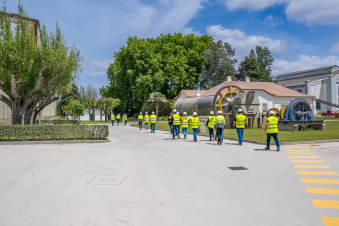In a business context, innovation extends beyond the development and delivery of new products, services, processes, and business models. It begins with aligning capabilities and activities to create value and drive economic and organizational growth.
Catarina Marques, a graduate in International Relations from the University of Minho with a master’s degree in Management from Católica Lisbon School of Business and Economics, where she also served as an assistant professor, is currently the Head of Innovation at Semapa. In this interview, she explains the significance of innovation within the Group and how it adds value.
What has been the role of innovation in Semapa Group’s journey?
Even though most of the companies within Semapa Group belong to traditional industrial sectors like cement or pulp and paper, these companies were pioneers in their time, born from innovative processes. When Secil began producing cement 100 years ago in Maceira or when Navigator started producing pulp 70 years ago in Cacia, they both did so based on truly innovative processes. Since then, it has only been through continuous innovation in their processes and products that they have been able to reach the level of development that both companies have achieved over time. This is the role of innovation: to foster a culture that ensures continuous improvement is a constant and that quantum leaps are always supported, to remain relevant and competitive.
Can you provide some examples?
To cite some recent examples, The Navigator Company has entered the packaging industry and started producing tissue. Secil “incubated” UTIS together with its partner and has also been creating cements that are tailored to the needs of architects. On the other hand, ETSA has invested in diversifying its final product with new solutions developed internally in its R&D laboratory. Triangle’s was born out of the desire to revolutionize the way bicycle frames are produced. These are just a few examples. The Group originates from a place of innovation; we are innovative by our very nature.
What is Semapa’s current innovation strategy?
Our goal is to add value to the innovation already occurring within the Group and to transition from reactive to intentional innovation, that is, how we are deeply responsible, from start to finish, for the innovation we generate. We want innovation to be a construct, not just a response. We understand that the importance of innovation lies not only in maintaining competitiveness in our current sectors, both now and in the future, but also as a crucial step to unlock new ways of doing things, achieving higher levels of optimization, efficiency, sustainability, and community engagement. Innovation, which has so far been very prepared to respond to efficiency, must be versatile enough to meet all challenges. The significance of innovation for Semapa Group is this: the relevance and viability of our sectors in meeting the future needs of humanity, because we are talking about the environment, communities, and, above all, people. Innovation involves this accountability and capacity for action.
How is the transition from reactive to intentional innovation achieved?
To achieve this transformation, we thoroughly familiarized ourselves with our companies within these areas of innovation. Understanding what worked well to have generated these solutions was necessary for us to leverage these good practices and processes and make them tangible. The step to transition from reactive to intentional innovation involves precisely creating the process and equipping teams with the necessary resources to innovate in a deliberate manner.
Are there different types of innovation?
When we talk about optimizing a process or our current product in our current market, we are discussing core innovation. This is crucial within the Group’s companies. For example, we are talking about optimizations to the color of paper or enhancements to the cement production process, making it more sustainable and efficient, among others. There is a goal in line with what each of our companies’ objectives are. When we deviate from our current product and market but remain close to the axis of this matrix, we start discussing adjacent innovation. This could mean, for example, entering a new market with a new type of paper or producing a new type of cement product. Finally, when we completely move away from our product and market, we talk about transformational innovation. These are the so-called disruptive ideas. Here, the goal is to generate businesses that may one day become the future portfolio of our company. A prime example of this type of innovation is the partnership in UTIS, which emerged as a technology with clear benefits for Secil’s energy efficiency and quickly expanded to conquer its market.
How will the objectives for the subsidiary companies be achieved?
It starts by creating a common language. An Innovation Forum was created, where all the companies in the Group participate. The Forum is the way to collaboratively build the goal of having all subsidiary companies with innovation even more ingrained in their DNA. Semapa, as the holding company of these companies, seeks to have an active, collaborative posture. We aim to build together areas that we believe can add value to our subsidiary companies. From this forum, a playbook will be created, the structural basis of what this process design, innovation structure, and innovation reporting is. This will allow us, in the future, to have companies oriented across the board to be more innovative. They will be able to communicate in the same language and synergistically create working groups. The idea is also that this playbook can help future subsidiary companies create their own processes and align more quickly with the Group’s practices.
Are you creating a culture of innovation within the Group?
I wouldn’t say “creating” a culture of innovation within the Group, as it has always existed, but perhaps a Group innovation culture. If all employees are contributing to the same innovation goal, inherently they will all know that this is part of their daily life and, therefore, part of the culture in which they are inserted. People need to be challenged to think differently, but they also need to have some space to be able to think differently. This is something that should be considered if our companies want to be more innovative across the board. I think we are all aligned in the sense that we do not want an isolated innovation structure. We don’t want innovation to be a department or an area, we want it to be transversal.





